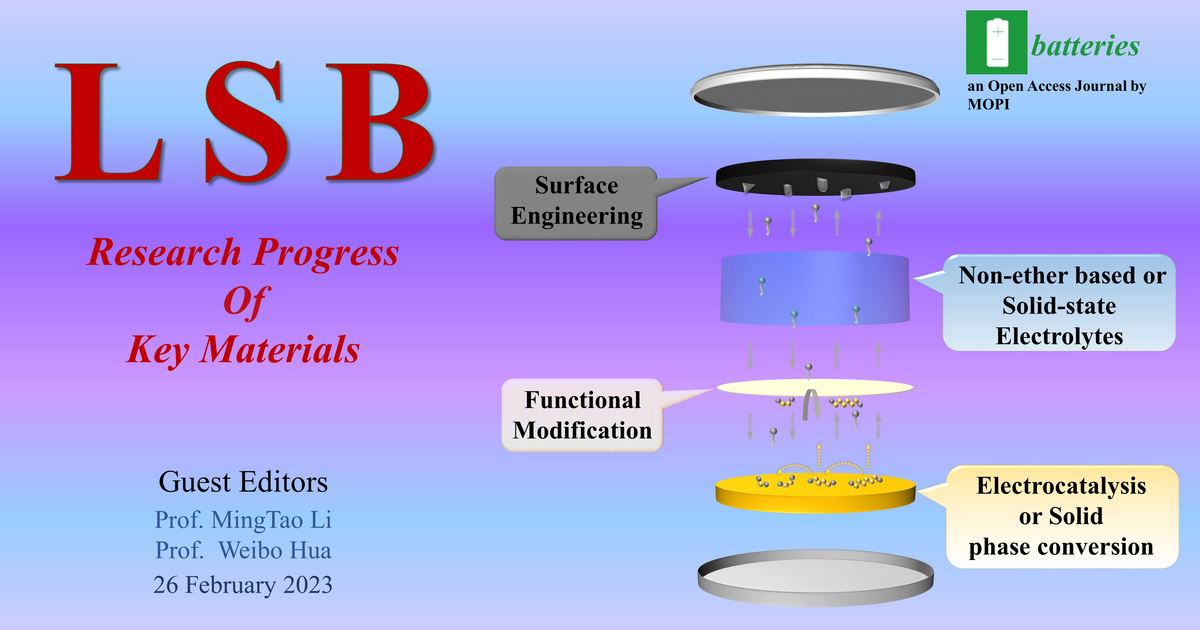- 4.8Impact Factor
- 6.6CiteScore
- 19 daysTime to First Decision
Lithium-Sulfur Batteries: Research Progress of Key Materials
This special issue belongs to the section “Battery Materials and Interfaces: Anode, Cathode, Separators and Electrolytes or Others“.
Special Issue Information
Dear Colleagues,
This Special Issue on Lithium-Sulfur Batteries is focused on the research progress of key materials. Aiming at the severe shuttle effect, the continuous consumption of electrolyte and the growth of lithium dendrites, how can we perform to substantially improve the practicability of lithium-sulfur batteries?
In terms of the main components of lithium-sulfur batteries, great enhancements of electrochemical performances have been made through electrocatalysis by polar substrates or solid-phase conversion by short-chain sulfur in cathodes, functional modification on separators, non-ether-based or solid-state electrolytes, as well as surface engineering on lithium anodes. Can these strategies be rationally designed and coupled to efficiently increase the energy density and lifespan for application?
This Special Issue welcomes novel research on key materials to promote the performance of lithium-sulfur batteries, and provides valuable guidance for their large-scale commercialization.
Prof. Dr. Mingtao Li
Prof. Dr. Weibo Hua
Guest Editors
Manuscript Submission Information
Manuscripts should be submitted online at www.mdpi.com by registering and logging in to this website. Once you are registered, click here to go to the submission form. Manuscripts can be submitted until the deadline. All submissions that pass pre-check are peer-reviewed. Accepted papers will be published continuously in the journal (as soon as accepted) and will be listed together on the special issue website. Research articles, review articles as well as short communications are invited. For planned papers, a title and short abstract (about 250 words) can be sent to the Editorial Office for assessment.
Submitted manuscripts should not have been published previously, nor be under consideration for publication elsewhere (except conference proceedings papers). All manuscripts are thoroughly refereed through a single-blind peer-review process. A guide for authors and other relevant information for submission of manuscripts is available on the Instructions for Authors page. Batteries is an international peer-reviewed open access monthly journal published by MDPI.
Please visit the Instructions for Authors page before submitting a manuscript. The Article Processing Charge (APC) for publication in this open access journal is 2700 CHF (Swiss Francs). Submitted papers should be well formatted and use good English. Authors may use MDPI's English editing service prior to publication or during author revisions.
Keywords
- lithium-sulfur batteries
- cathode
- electrolyte
- polysulfide
- lithium anode
- dendrite
- functional coating

Benefits of Publishing in a Special Issue
- Ease of navigation: Grouping papers by topic helps scholars navigate broad scope journals more efficiently.
- Greater discoverability: Special Issues support the reach and impact of scientific research. Articles in Special Issues are more discoverable and cited more frequently.
- Expansion of research network: Special Issues facilitate connections among authors, fostering scientific collaborations.
- External promotion: Articles in Special Issues are often promoted through the journal's social media, increasing their visibility.
- e-Book format: Special Issues with more than 10 articles can be published as dedicated e-books, ensuring wide and rapid dissemination.

